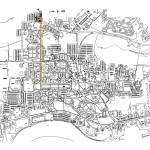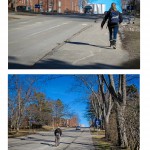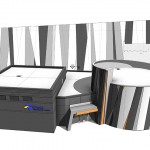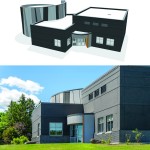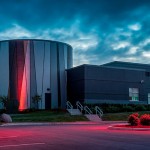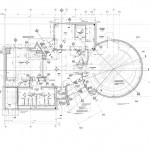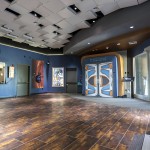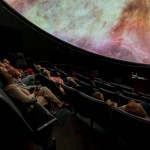Emera Astronomy Center and Maynard F. Jordan Planetarium
Project Name
Suspension of Disbelief: How might the approach to the building through campus, the arrival at the site, and the entry sequence be choreographed so that the building actively participates in the astronomy center’s theatrical mystery?
The Set and Setting: Uniquely situated upon a hilltop, the building design takes advantage of the site and campus approach. From the center of campus, the approach begins at the bottom of the hill, with the building almost hidden. As the gentle climb begins, the planetarium and its unique wrapper emerge from the horizon, like the “rising” sun and the moon. Shades of gray and orange materialize, camouflaged like a WWII battleship, behind trees and other buildings until, as the crest of the hill advances, the portal into the main entrance is revealed. At evening show times, the building is set aglow by LEDs, making the ascent even more dramatic.
Building Skin and Celestial Cartography: The design intends to draw attention to the iconography of the planetarium by carefully shaping its form and figure in a simultaneously common, i.e. cylindrical, and yet unexpected way, i.e. peeling and flaring skin.
Charged with creating a theatrical experience for all ages, we imagined the opportunity to merge the ancient art of mapping and modern imaging through a playful game of connect the dots (stars) by tattooing it onto the skin of the building. We orthographically overlaid the ground and roof plane of the planetarium onto the resulting connect the dot diagram and used 3D software to wrap the vectored graphic around the 3D Revit model. Next we used the direction of the vectors to populate the image with achromatic shades of gray and at key moments carved away portions of the facade to reveal a metallic orange inner core behind the skin.
Close and Far Reading: Similar to the study of stars at multiple scales, the big black box of the building reads as a monolithic volume from afar, but as the eye approaches the individual units of the brick and stucco cladding, articulated with mica infused into the mortar, catch the shimmer of the sun light as the day advances, transforming the monolithic box into a palpable and animated surface to the passerby.
The final theatrics, therefore, become a function of time, weather, the season, the director’s exhibits and the experience of the architectural vocabulary put together in its final form through the perception of the user.

